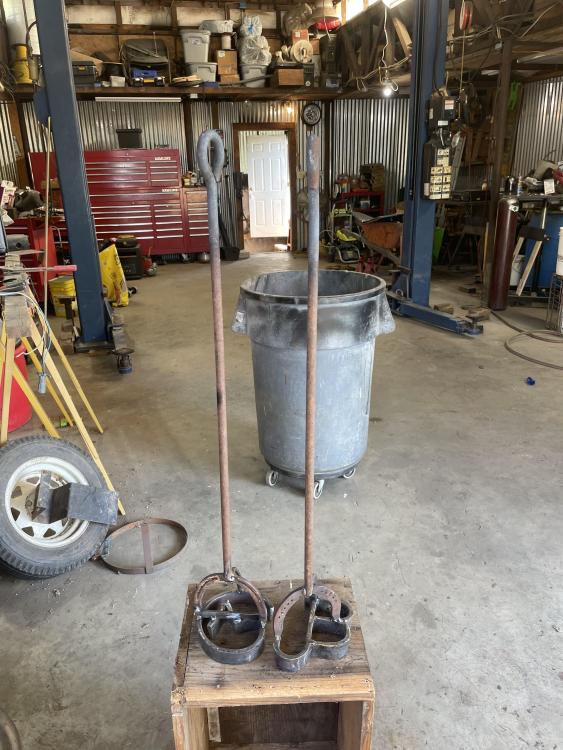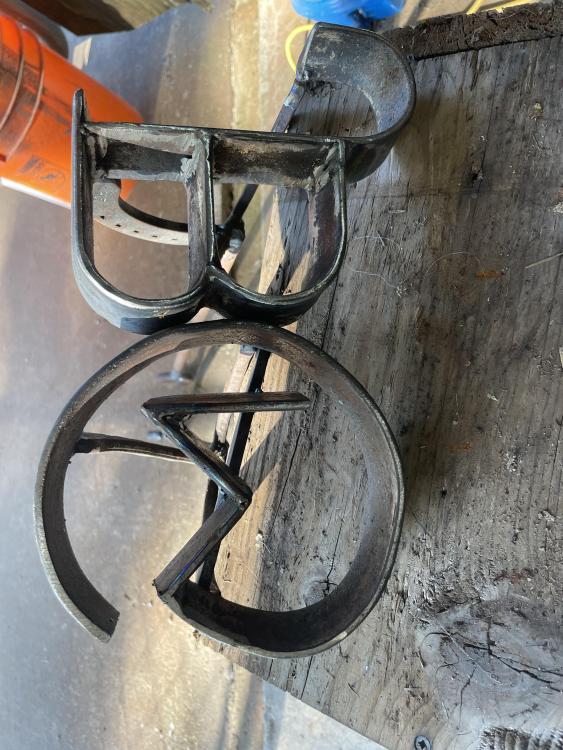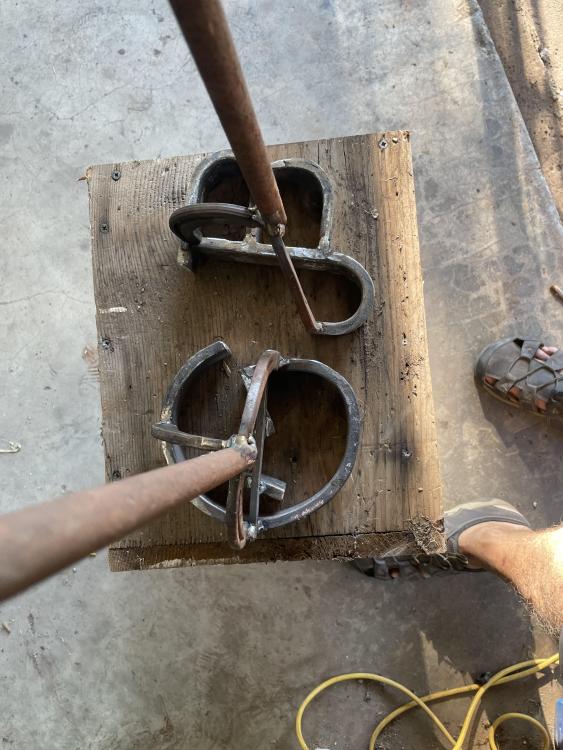-
Posts
9,374 -
Joined
-
Last visited
Content Type
Profiles
Forums
Articles
Gallery
Downloads
Events
Everything posted by Charles R. Stevens
-

How not to start your Saturday morning
Charles R. Stevens replied to TWISTEDWILLOW's topic in Everything Else
From my point of view, dogs have failed for a reason. I have never Ben bit breaking up a fight when I had one buy the tail. aussies are different, seems like they change after 18 months. Become very territorial and protective of their charges. -

What did you do in the shop today?
Charles R. Stevens replied to Mark Ling's topic in Blacksmithing, General Discussion
Doable, but I think it will smear… might have to do a multi piece set -

What did you do in the shop today?
Charles R. Stevens replied to Mark Ling's topic in Blacksmithing, General Discussion
Outstanding TP. Jerry, I think she intends to mark her property. Her Dad and I have to hold cris down… -

My homemade anvil
Charles R. Stevens replied to Seth21's topic in Anvils, Swage Blocks, and Mandrels
Mine is graduated down both sides, about a 1/4” radius at the horn to 1” at the heel. This gives one more options. I would set up a ruble horn the other way. -

My homemade anvil
Charles R. Stevens replied to Seth21's topic in Anvils, Swage Blocks, and Mandrels
Only relive the right side if you forge from the wrong side! Horn to the left is the way farriers do it. Blacksmiths have it backwards ;-) -

What did you do in the shop today?
Charles R. Stevens replied to Mark Ling's topic in Blacksmithing, General Discussion
-

Railroad rail sections
Charles R. Stevens replied to Gazz's topic in TPAAAT - Applied Anvil Acquisition Technique
Nice. Give them a link to -
Suzuki samurai or an Isuzu NPR here. I drag way to much home with the cabover!
-
My old shop teacher would be proud, I reach for hand tools more and more these days, I have always shod with hand tools, as it keeps my truck much lighter. That and the ability to forge specialty shoes limits the amount of shoes I carry. I instead carry showing stock.
-
Don’t sweat it, Anvil. I have been biting my tong and biding my time (don’t want a repeat of the “crawl back under your bridge” insolent). I figure he, like many others has had a bad year. Besides is thinking the world is going to “Hell in a hand basket” really politics, lol. besides hot steel will thicken his hide fast enough, as will some rough and ready blacksmith humor.
-
Working and hobby farms always have fabrication and repair projects to do and once you have a forge and anvil a surprising number of them require a bit of forging ;-). a mixing aside, what manner of forge are we looking at? This has a Bering on what work one can do efficiently or how many forges you need to work efficiently (gassers) what anvil and tools do you have at hand? Do we need to find an anvil (commercial or improvised) or other tools? lone hopes all the equipment rusting in the wind rows hast been sold for scrap.
-
Kooky, your not fhe only one here with a diagnosis or two. Type II bipolar illness, PTSD, dyslexia and ADD, myself. We have more than one member with SMI’s, as well as TBI’s, and other physical disabilities and ailments. Your not alone, and IFI has a good track record of respectfully accepting that. Ethnicity, sex, sexual identity and preference as well as faith are equally represented and excepted. Believe it or not so is age and employment status. now I don’t think anyone would seriously argue that averaging 1.5% wage growth in the face of 3% average inflation since Reagan has helped the American worker, but blacksmithing is usually a boot straps self employed business in this day and age. when some one like TP says to go out and mow lawns and save up for basic tools and then to sell bottle openers to wake up for your dream anvil, he is suggesting that the basic idea that working for “the man” might not get you where you want to be, nor will sitting on your backside wishing. Leo you have started on the path my young friend. It’s not well marked nor is it smooth. It is well traveled and rutted however.
-
Not to forget the pages and pages of information here. IFI is an interactive pier reviewed document. As JHCC coined the frase “JABOD” after the Just a box of dirt forge thread in the solid fuel forge stickies. That might be a good place to start to learn about them. many of the YouTubers over complicate things that they don’t take the time to understand in a rush for ratings. the same thing has happened with ASO or anvil shaped object coined here as well.
-
Google bushcraft blacksmithing and check out Beltram’s set up. He has 3 anvils that would be at home 500 years ago, and shows how to set up a simple ground forge. lit will give you ideas
-
A common thing is for the old salts to not only be talking to you but the lurkers and those who discover this thread in the future. So if some one has a couple of grand to drop on starting a forge and buying good tools and equipment, we aren’t trying to talk you out of it, nessisaraly. Many of us can show you how to set up a forge and forge usable stuff for $100 or less, and we want others to understand that they can too.
-
Honestly a 10# sledge hammer head and a 24oz ball pein cover the hammer and anvil for most chisel and plane blades, heck small bowl ads and carving hatchets can be maid on such
-
Check the improvised anvil thread out I am always a fan of low initial investment for non junk tools to get your feet whet then move on to more pricey tools after you know you will use them.
-
There are a lot of online sources for books as well. Some of the survivalist and bushcraft forums have free PDF libraries as well as the third world extension services. The UN agricultural engineering department has a 3book series that is particularly nice. there are some pre copyright boacksmithing manuals out there as well, of particular interest are the power hammer manuals as they have some very good information on how to block out or isolate different parts of your work as well as order of operations to work more effetently. Tho power hammer hand tooling looks very different it will give you ideas for quick and dirty toolin for one off operations as well as angel tooling for repeatable operations. Remember that hand forging and power hammer forging are more alike than not. The hammer and anvil are just hand held dies after all As for as gas’s forges, Mike and Frosty over at the forge 101 and burner 101 threads have forgotten more than I ever knew about gas forges. Most factory forges need some work such as rigidizer and an IR coating out of the box to be safe and effetient
-
The skills learned have value as well, lol. The funny thing is the same person scooting the use of A36 will bad mouth the use of rebar. I personally treat it all as found steel. now on the subject of anvils, not a fan of I beam, you need something thicker. If nothing else use a sledge hammer head. For Thousands of years anvils where just solid chunks of iron 5-10# with 1-1/2-2# hammers. lit has been said before that earth movers are just a pile of anvils bolted together…
-

Wood/charcoal forge build questions and request.
Charles R. Stevens replied to Jeff Pugh's topic in Solid Fuel Forges
I second the charcoal retort, especially the kiln style. Short of that a fire to harvest coals and move to your forge is much cooler, working so close to a live fire sucks. I don’t recommend a bottom blast for charcoal, but a side blast trench style forge for fuel effecency. 6” deep, 4” wide and about 8” long with the 3/4” schedule 40 tuyere (about 7/8” ID) works well for me. I melt fire bricks on occasion, if you don’t think it will get hot… look at the charcoal/side blast stickies for a start, if you have any questions after that let me know. -
Their is rebar and then their is rebar. Some rebar such as bridge and sky rise bar may well be consistent known steel. Wile the stuff from the big box store is mystery metal and may very in consistency with in the same stick. A-36 is almost as bad, as it to is made to an engorging spec, not a metelergical one don’t believe me just bend over 2” of the stuff and forge weld it, cut off and repeat. Steve and I found a spot that even he couldn’t weld. now all that said, mystery metal rules apply. Forge some and see if it air quenches, oil quenches, water quenches etc. will it forge weld with out extraordinary mesures? The stuff I get from the box store will air quench, so didn’t make good forged stakes but makes good quick and dirty chisels and punches. Wile some I have in my stash is actually D2 so just be aware that rebar and to a lesser extent A36 are mystery steels and add to the learning curve.
-
As mentioned, threaded weight lifting bars work well, as dose scaffolding leveling legs, screws salvaged from cheap woodworking vices and the stews from old car jacks. they all have fairly fast (corse low thread counts) acme threads. Regular threaded rod works as well, but generally are not as fast and are not designed for repeated treading in and out. Thus they wear out and eventually will strip. wood screws are a classic, and the tap and die needed can be home built but it is a real PITA. Expect to spend all weekend building and adjusting half the set.
-
Nice work all the way around. might I suggest looking at Rex Kruger’s YouTube site. He has a good video on an angled leg vise. If you want to keep with your DIY vibe (your a smith/ woodworker after all) a flea market barbell and a few pipe fittings make a fine pair of vise screws. Christopher Schwarz. has some great articles on his web site concerning toolbox tills and orginasation. I know Rex lurks here from time to time.



